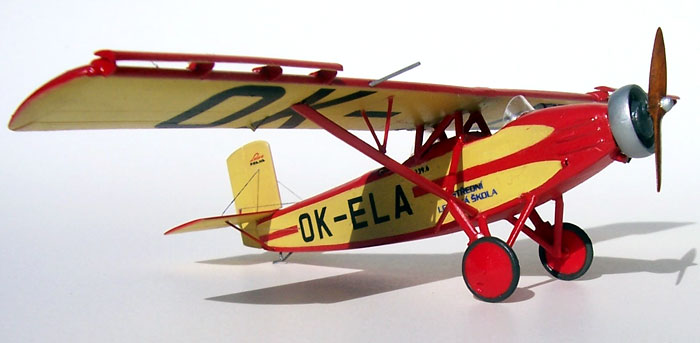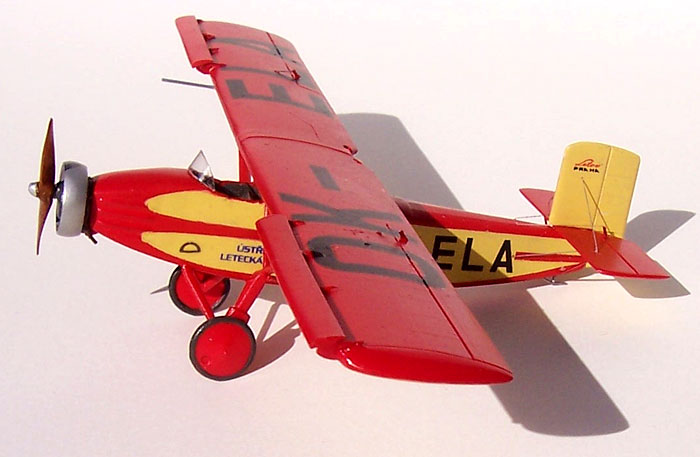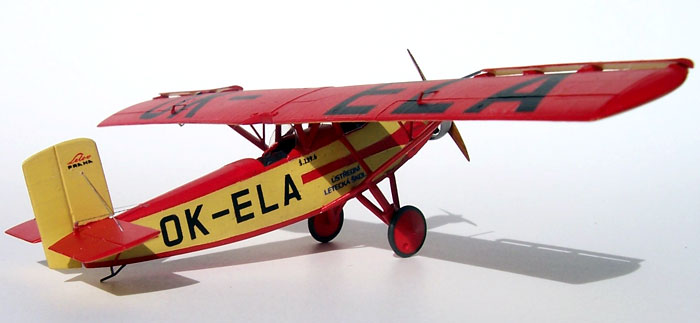|
Legato's
1/72 scale
Letov S.139
by Mark Davies
|
 |
|
Letov S.139 |

HyperScale is proudly supported by Squadron.com
I have had little success in finding information in English on the
Letov S.139. I have however managed to find several photos and some
excellent plans that show it was part of a family of civil light
sporting planes featuring parasol wings with fixed leading edge slats,
and a variety of small engines. These were designated the S.39, S.139
and S.239. Air cooled engines used included 2-cylinder horizontally
opposed, 3-cylinder (Walther Polaris I think), 4 or 6-cylinder inline,
and a 5-cylinder geared radial that looks like a Podjoy.

I soon as I saw the Letov S.139 on the Modelimex on-line shop I knew I
had to buy one. Such a strange and quirky looking aircraft with the
passenger in front of the parasol wing and the pilot behind it, plus
fixed leading edge slats and plank-like fin and rudder proved
irresistible to me. This was because of several reasons - I like Golden
Age civil aircraft, I wish to increase the Czech subjects in my
collection as an acknowledgement of a strong email friendship I have
with a Czech aviation and model enthusiast, and I love “clunky” looking
planes. A bonus was the attractive colour scheme (which by the way seems
to have been of this family of Letov aircraft).
The Legato kit is quite simple with a limited number of resin parts, a
comprehensive Photo-Etch (PE) fret, and small acetate sheet with
instruments and windscreen outlines, plus decals. The instructions are
very small and basic, with plans on their reverse. The photo-copy
quality of the plans is not that good. It is apparent that the same kit
is the basis for all three versions mentioned above, as it is engineered
to have different noses and engines forward of the front cockpit.

There are few pinholes, but several of the smaller the struts are
generally too thick. In hindsight I wish I had replaced the cabane
struts with styrene like I did for some of the undercarriage and wing
strut components. The PE fret provides seat belts, instrument panel,
eight fiddley mounts for the leading edge slats, boarding step
surrounds, control horns and one or two other items. I can’t say how
many times I broke the slat mounts off, but I finally lost one
permanently and replaced it with 5 thou plasticard. Getting all of the
struts right was a bit of a challenge as they are complex and model is
quite small. At some stage I lost the acetate film, so I had to make my
own windscreens which was no great challenge given their simple shape. I
also made my own exhaust pipes after loosing the resin one on the floor
somewhere.
Painting was a bit tricky, not least because all you have to go is the
box-art profile. Fortunately I found two or three photos of the actual
plane featured in the kit that provided a good guide for demarcation
areas between colours. I painted and masked the red first, followed by
the cream. Decals were a bit fragile and brittle, and despite going on
over a good Humbrol gloss they silvered badly on the wing registrations.
and this took some fixing. In hindsight I should have floated them on
with Future, but at the time they seemed to go on very well.

This was not the best resin kit I have made, but it was quite reasonable
quality overall with generally good fit.
At 19 Euros plus postage it landed in New Zealand for 38 Kiwi
Dollars. So whilst certainly not cheap, it was worth the price for the
unusual subject.
I have heard Legato is moving away from resin kits to focus on
producing AZ Models multi-media injected kits, so I would recommend
anyone who likes the subject and has some experience with resin kits buy
one before they possibly cease to be available.
Model, Images and Text
Copyright © 2007 by
Mark Davies
Page Created 13 September, 2007
Last Updated
24 December, 2007
Back to
HyperScale Main Page |
Home
| What's New |
Features |
Gallery |
Reviews |
Reference |
Forum |